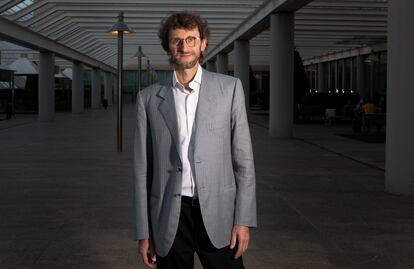Franco Sassi: ‘We need to maintain very powerful incentives for the food industry to reformulate its products’
The professor of Economics and International Health Policy warns that children from depressed environments have a greater risk of being overweight and obese


The silent epidemic of this century, obesity, knows no age. According to the latest data from the World Health Organization (WHO), 29% of children aged 7 to 9 in Europe are overweight or obese. For Spanish children, the percentage shoots up to 39% in the case of Spanish children. To address the issue, experts met in Palma de Mallorca last week for a forum on childhood obesity. They discussed childhood obesity programs, studies about risk factors and possible policies to apply in the future.
Among the experts who participated is Franco Sassi, professor of Economics and International Health Policy at Imperial College London and director of a consortium that is developing a project on the application of science and technology in childhood obesity policies. Sassi’s work aims to evaluate the impacts of public policies to address chronic diseases and their risk factors. Together with other international experts, he will spend the next five years working on a European project that aims to analyze and study the risks of obesity at each stage of life.
Question. Is obesity the most important epidemic of the 21st century?
Answer. Yes, obesity is one of the biggest public health epidemics around the world. It is an epidemic for two reasons; the first because it affects many people, and the second, because it spreads like a virus, especially socially, because people make choices such as eating unhealthy food or having a sedentary lifestyle, and others are influenced to do the same. Obesity spreads like a virus. It is a worrying epidemic, the most serious for public health at this time because tobacco is in decline and, although alcohol consumption is still high in many places, especially in many countries in the European region, obesity is growing around the world with an escalation that we have never seen before.
Q. According to the latest data from the World Health Organization (WHO), in Spain, 39% of girls and 38% of boys aged 7 to 9 were overweight or obese. Along with Greece and Italy, Spain has the worst figures, far from those reported by northern countries such as Denmark. What has happened to the Mediterranean diet?
A. It has changed completely. People eat foods that are very unhealthy. These foods are pushed by very strong marketing from the companies that produce them. There is very little that our children can do to resist that marketing and peer pressure.
Q. Less than half of children in Spain consume fresh fruit daily, and half of them do less than two hours of exercise a week. Which of these two factors, poor diet or a sedentary lifestyle, triggers the risk of obesity or overweight among children first?
A. Both are very important, I would say equally important. The problem is that we can do much more to improve diet than we can to improve children’s physical activity. Unfortunately, it is very difficult to give up screens and digital devices. We try, but it is very difficult to change the level of physical activity that minors do, we can change it to a certain extent, but not much. It is in the food part where we can do much more, because the reasons why children do not eat fruits and vegetables are because they have not been educated to eat them. There are also other important factors, such as the fact that they are much more expensive foods than others that have much more intense marketing, that have cheaper prices and that are less healthy. So if we only advertised healthy foods and used the tax system to make nutritious foods more convenient than processed foods, we could incentivize proper diet more strongly.
Q. Are policies to tax processed foods or sugary drinks effective?
A. They work, the short answer is yes, there is very strong evidence. There are recommendations from international organizations for the application of taxes for sugary foods and drinks. There are dozens of studies that analyze precisely the effects of these sugary drinks and that consistently support the consequences of these taxes on soft drinks, with a ten percent reduction in consumption for every ten percent increase in the price of drinks.
Q. Are they increasingly adopted by countries? Can they serve to help break the cycle?
A. It is a type of policy that more and more countries are adopting, the problem is that we cannot stop there. Sugary drinks are important in children’s diets, but they are not the only cause of childhood obesity. So we need to extend tax policies to other types of food.
Q. Is it the socioeconomic factor of families that determines the risk of suffering from obesity?
A. Socioeconomic level is undoubtedly a very important factor. Children who live in more depressed, low-resource environments are exposed to a much stronger influence of unhealthy foods. They walk around the neighborhood and only see fast food stores, they only see establishments that sell unhealthy food and it is difficult for them to find healthy food at affordable prices. They are overexposed to unhealthy food marketing and, of course, have less ability to discriminate between unhealthy and nutritious foods. So low socioeconomic levels make children more exposed to this epidemic.

Q. How can public policies contribute to breaking this cycle?
A. There is not one single policy that can solve the problem. You need as many policies as the government is able to implement, because every policy taken in isolation will have a relatively small effect, and the problem is so big that we really need multiple policies to make a big difference. So the main policies for children are those that happen at the school level. This is a critical age, primary school in particular, because you don’t want children to develop obesity while they are in primary school because the critical age for future outcomes is when they are adolescents. So if they get to 13, 14 years of age with obesity, they are very likely to have obesity in adult life, and we want to prevent this. So we need to act at the primary school level. But also you need to act on young families. So you need to create the conditions for young women in particular, but young families in general, to have a healthy life and have access to healthy food so that they can have a healthy body weight and give birth to children who are likely to be healthy themselves and live a life without obesity.
Q. Is food control in school cafeterias a measure that can help reduce the problem?
A. There are at least two types of policies that happen at that level. One is food procurement, what schools purchase in terms of the foods that they then cook for the children. And the second type of policy is how you create an environment that is conducive to healthy eating, like small portions, the layout of foods in the canteen that prioritizes healthy food. We know perfectly well that the way food is laid out in the canteen influences children’s choices. So depending on whether we put fruit and vegetables at the start or at the end of the pathway, they will have a completely different menu on their tray. So we need to use these policies that we call nudges to influence their behavior in the canteen and make sure that they eat healthy.
Q. What weight do diseases derived from obesity have in public health systems?
A. It’s a huge burden. As it has been said today, children with obesity are likely to grow into adults with obesity. That means early onset of diabetes, cardiovascular disease, some types of cancer, and many other diseases which affect their productivity, their ability to participate actively in economic production, as well as their demand for medical care, which can be very large, particularly now with the availability of effective treatments for obesity. The likelihood that people will be complacent about their lifestyle and then end up needing drugs or even surgery is very high, and these treatments cost a fortune. Government and health systems would not be able to afford them in the long term.
Q. What details can you offer about the macro-project in which specialists from several countries will embark for five years to study the factors that contribute to the development of obesity?
A. With the OBCT project (Obesity: Biological, Sociocultural and Environmental Risk) we hope to be able to reveal the factors that influence obesity and how we can identify the main triggers at different stages of life, to identify solutions and the policies that can be applied to reverse them.
Sign up for our weekly newsletter to get more English-language news coverage from EL PAÍS USA Edition
Tu suscripción se está usando en otro dispositivo
¿Quieres añadir otro usuario a tu suscripción?
Si continúas leyendo en este dispositivo, no se podrá leer en el otro.
FlechaTu suscripción se está usando en otro dispositivo y solo puedes acceder a EL PAÍS desde un dispositivo a la vez.
Si quieres compartir tu cuenta, cambia tu suscripción a la modalidad Premium, así podrás añadir otro usuario. Cada uno accederá con su propia cuenta de email, lo que os permitirá personalizar vuestra experiencia en EL PAÍS.
¿Tienes una suscripción de empresa? Accede aquí para contratar más cuentas.
En el caso de no saber quién está usando tu cuenta, te recomendamos cambiar tu contraseña aquí.
Si decides continuar compartiendo tu cuenta, este mensaje se mostrará en tu dispositivo y en el de la otra persona que está usando tu cuenta de forma indefinida, afectando a tu experiencia de lectura. Puedes consultar aquí los términos y condiciones de la suscripción digital.
More information
Últimas noticias
Most viewed
- Oona Chaplin: ‘I told James Cameron that I was living in a treehouse and starting a permaculture project with a friend’
- Sinaloa Cartel war is taking its toll on Los Chapitos
- Reinhard Genzel, Nobel laureate in physics: ‘One-minute videos will never give you the truth’
- Why the price of coffee has skyrocketed: from Brazilian plantations to specialty coffee houses
- Silver prices are going crazy: This is what’s fueling the rally










































